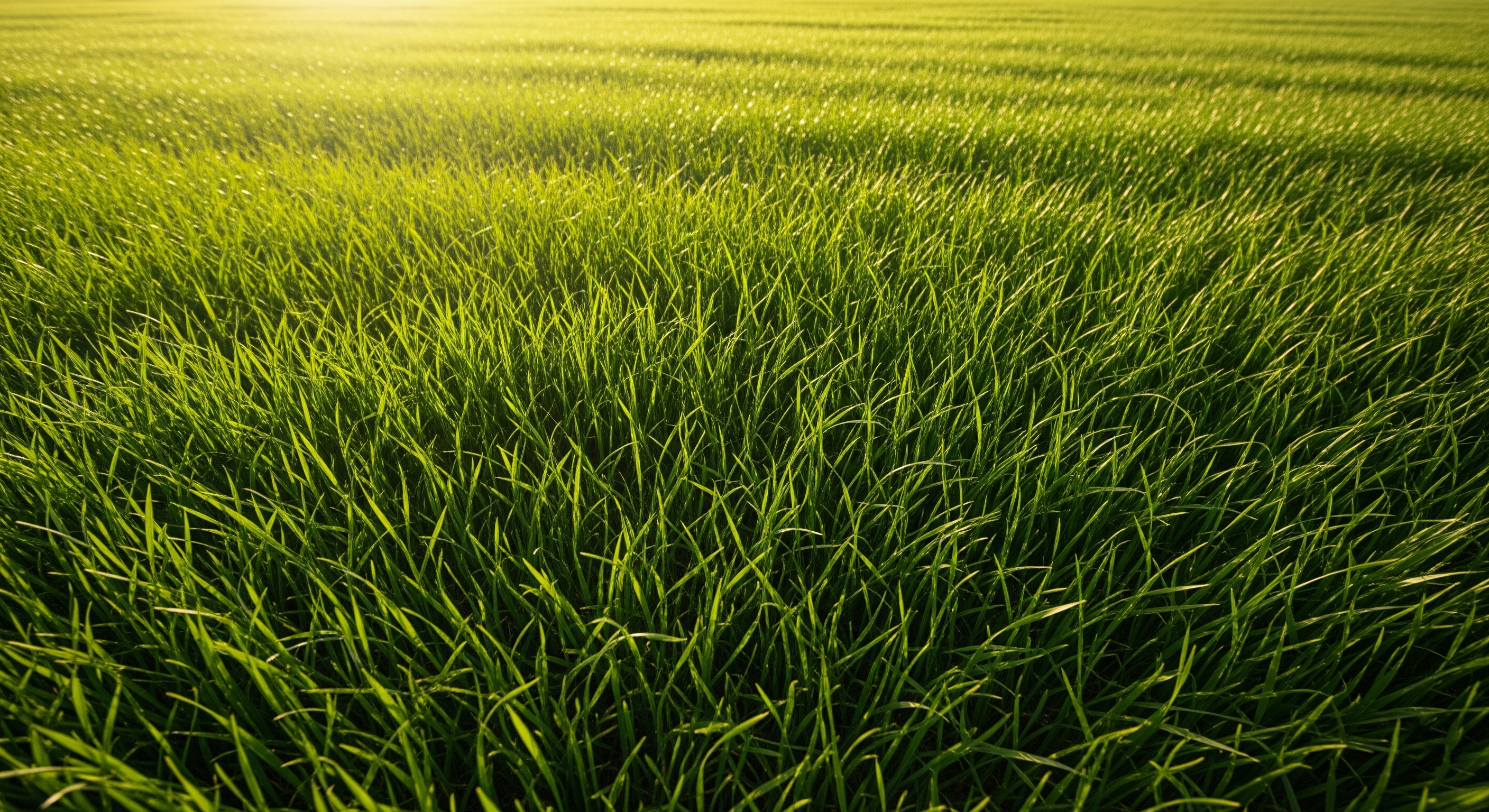
Kentucky Bluegrass
Self-repairs but slower to establish
Lolium perenne
When you need grass quickly, Perennial Ryegrass is the answer. Germinating in just 5-10 days, it's the top choice for fast patches, overseeding thin lawns, and establishing new turf when time matters. Sports field managers love it. Homeowners appreciate it. Even golf courses depend on it for winter overseeding.
Unlike annual ryegrass, which dies after one season, perennial ryegrass comes back year after year in northern climates. In the transition zone and the South, it's often used as a temporary winter grass over dormant warm-season lawns, providing green color when Bermuda and Zoysia turn brown.
The leaves have a distinctive glossy appearance on the underside and are almost shiny compared to other grasses. The blades are folded in the bud (vernation), emerging with a clear crease down the middle. This folded vernation distinguishes it from Kentucky Bluegrass, which has rolled vernation.
Look for prominent veins on the top surface and a smooth, hairless texture. The leaves taper to a pointed tip, lacking the boat-shaped tip of Kentucky Bluegrass. Width ranges from 2 to 6mm, creating a medium-fine texture.
Perennial Ryegrass grows in bunches or clumps and does not spread through rhizomes or stolons. This bunch-type growth means it won't fill in bare spots on its own, so overseeding is necessary for thick coverage. Individual plants can develop large tiller systems, forming dense clumps.
The collar area shows key identifiers. You'll notice claw-like auricles (ear-like projections) grasping the stem - a feature that immediately distinguishes ryegrass from fescues and bluegrass. The ligule is membranous and relatively short (1-2mm).
Outstanding wear tolerance makes this the preferred grass for athletic fields and play areas. Its robust growth and quick recovery from damage mean it handles foot traffic better than Kentucky Bluegrass or Fine Fescues. Many professional sports fields use perennial ryegrass blends.
Nothing beats perennial ryegrass for quick establishment. While Kentucky Bluegrass takes 14-30 days to germinate, ryegrass sprouts in 5-10 days under ideal conditions. You'll have a mowable lawn in 3-4 weeks from seed.
Newer varieties demonstrate improved resistance to diseases such as brown patch, gray leaf spot, and pythium blight. However, they remain susceptible to rust and red thread, particularly in humid conditions with poor air circulation.
Optimal growth happens between 60-75°F. It survives winters in zones 3-7, but extreme cold without snow cover can cause damage. Its heat tolerance is moderate and struggles when temperatures regularly exceed 85°F. It goes dormant during hot, dry summers without irrigation.
Requires consistent moisture for optimal appearance. Needs 1-1.5 inches of water weekly during active growth. Has poor drought tolerance compared to tall fescue or Kentucky Bluegrass. Exhibits stress quickly with wilting and footprinting.
Performs well in various soils but favors fertile, well-drained conditions with pH 5.5-7.5. Tolerates compacted soils better than most cool-season grasses. Clay soils are suitable if drainage is adequate. Sandy soils need more frequent watering and fertilization.
Maintain mower height at 1.5-2.5 inches for home lawns and lower for athletic fields. Grows rapidly during spring and fall, so mow twice a week during peak growth. Use sharp blades because the tough leaves can be hard to cut cleanly.
Moderate feeder requiring 2-4 pounds of nitrogen per 1,000 sq ft annually. Apply mostly in fall with light spring applications. Responds quickly to fertilization with rapid growth and dark green color. Over-fertilization causes excessive growth and thatch.
Since it's a bunch grass, regular overseeding helps maintain density. Overseed annually at 3-5 pounds per 1,000 sq ft. Fall overseeding works best in northern areas. In the South, overseed dormant warm-season lawns in October to add winter color.
Generally fewer pest issues than Kentucky Bluegrass. Billbugs can be troublesome in certain areas. Rust shows up during slow growth periods in high humidity. Gray leaf spot affects ryegrass in hot, humid conditions.
This is the standard for sports turf due to its wear tolerance and quick establishment. Many fields use 80-100% perennial ryegrass or blends with Kentucky Bluegrass. It recovers quickly from cleat damage.
Ideal for quickly thickening thin lawns. Germinates rapidly enough to compete with weeds. Use for patching damaged areas or overseeding warm-season lawns to add winter color.
Quick germination makes it ideal for stabilizing slopes and preventing erosion. It is often used as a nurse crop while slower-establishing grasses grow.
Ideal for families with children and pets. Handles backyard soccer games and dog walks better than most grasses. Mix with Kentucky Bluegrass for self-repair ability.
Enhances drought tolerance and disease resistance. Dark green color with a fine texture. A good choice for water-conscious homeowners.
Latest generation with superior turf quality. Excellent wear tolerance and quick establishment. Dark green color lasts through stress.
Bred for sports fields with excellent traffic tolerance. Quick germination and vigorous growth. Strong resistance to gray leaf spot.
Fine texture with enhanced heat tolerance. Dense growth habit and dark color. A good choice for overseeding existing lawns.